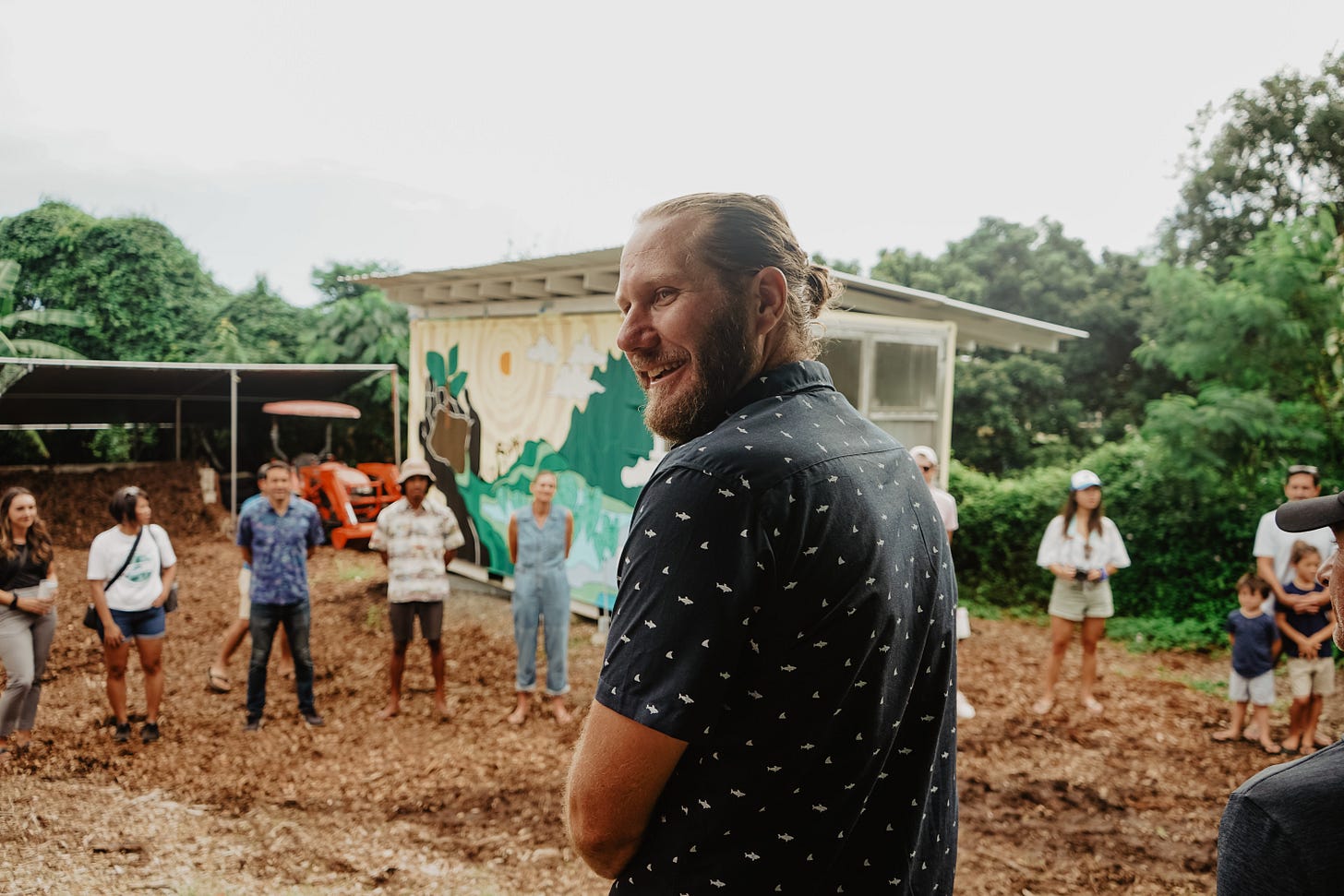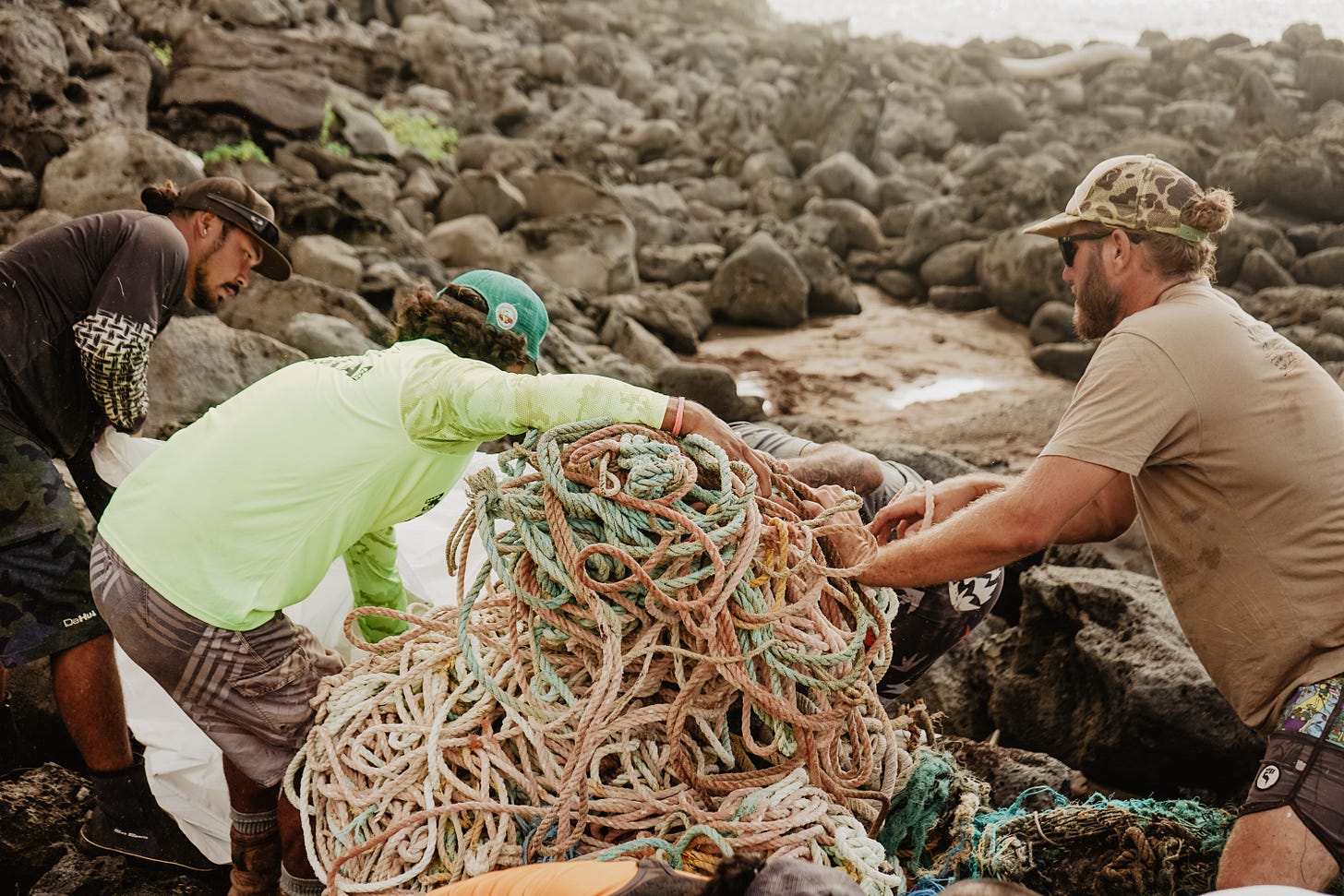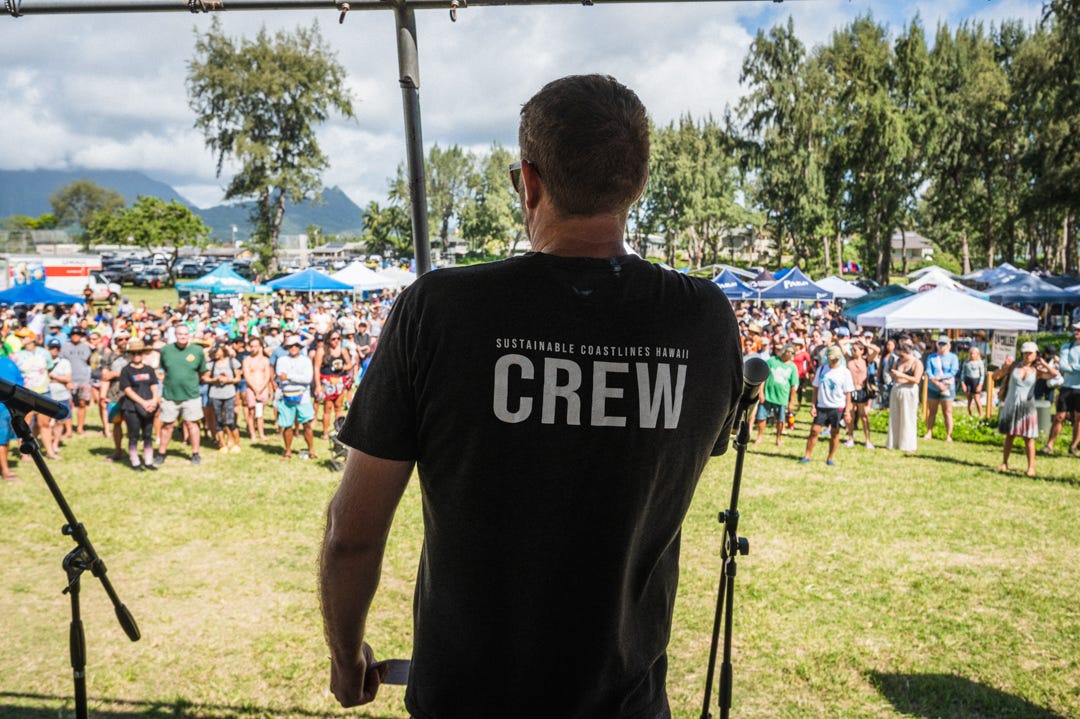earthlove guest #4
Rafael Bergstrom, creative and Executive Director of an incredible nonprofit
I first met Rafael Bergstrom in 2018 on the Hawaiian island of Oahu. This meeting sparked an ongoing relationship between the non-profit Sustainable Coastlines Hawai’i (SCH), where Rafael serves as Executive Director, and Free the Ocean, the company I co-founded and ran for 5 years. We worked closely with him and SCH, helping fund their beach cleanup and education efforts. Over the years, I came to know Rafael for the caring, inspiring, and extremely hard working person that he is.
As the ED of a thriving non-profit, a creative and artist, husband, and active community member, he has a very full life. I really appreciate him taking the time to share his earthlove with us.
Let’s jump into it…
MA: You’re the Executive Director of Sustainable Coastlines Hawai’i - an amazing nonprofit dedicated to making a difference on plastic pollution by inspiring changes in consumer behavior and promoting coastal stewardship through cleanups, education, social media, and more.
You clearly care deeply about our planet, so please tell us, how do YOU share your earthlove (your deep love of the earth)?
RB: Luckily for me, my life is centered around building on my earthlove. I should mention that love is built on a foundation created by a generational gift from those who came before me. From my parents to my grandparents, I had behavior models that demonstrated the simple power of observation and reverence - or ilihia in the Hawaiian vernacular - for the natural world. From growing up along the American River Parkway in Sacramento to understanding the work my grandparents did to protect a forest from development in their neighborhood, I have grown to realize the power of both the simple indulgence of being immersed in nature and the necessity of stepping outside of ourselves to protect it.
That foundation has given me a guiding light in understanding how to illuminate the earthlove that I have. The simplest way that I express that earthlove is through spending time in nature, taking photos, reading about it to find a deeper understanding, and then sharing about what I have experienced and/or learned. My favorite ways to do that these days is through a combination of my photography and writing. I use these creative outlets as methods for taking the time to pause and appreciate the gifts of the earth and then to share them with others. My newest project is my weekly newsletter – MMM: Making Mondays Meaningful – a platform where I get to share more depth and nuance about things that I care about than most social outlets provide a platform for these days. I also catalogue my photographic journey on my website – Raftography.com.
The other piece of the puzzle - stepping outside of ourselves to protect the world that gives us life – I am lucky enough to actuate by having my job at Sustainable Coastlines Hawai‘i be a daily pursuit of this. I’ll share more about SCH in the questions that follow, but the beauty of this work is the possibility of igniting community in collective action to pursue a more sustainable future. Without having that ethos of earthlove come to the forefront of our daily lives, we are not going to survive as a species. At SCH we get to find ways to translate problems like plastic pollution into motivation for action that reconnects people to the opportunities that we have right in front of us to make positive change.
MA: You call O‘ahu, Hawai‘i, home. Describe what it’s like to live on an Island in the middle of the Pacific!
RB: It’s magical. It’s challenging. It’s inspirational. It’s a privilege. It’s terrifying. It’s my home.
Living in Hawai‘i is nothing short of spectacular and awe-inspiring. You walk outside every day to this stunning landscape where the mountains meet the ocean, where deep greens of the jungle mingle with the turquoise blues of tropical waters, where lava bubbles/explodes to create new earth (not on O‘ahu), where the weather lets you be comfortably immersed in nature year-round, and where a cultural history that miraculously survived the onslaught of of western colonialism continues to remind us of the possibility of being connected to each other through our connection to ‘āina (land/earth).
It’s also a very challenging place to live. The cost of living in Hawai‘i is shocking at times, but more concerning is that the current way of life is so disconnected from a resilient reality that it actually makes it frightening. The forces of consumerism, renegade capitalism, and an ethos of “I want what I want when I want it” continue to put Hawai‘i at risk. Everything is imported – food, cheap crap we don’t actually need, and tourism and the military as handcuffing industries for jobs. It’s not sustainable and puts the entire island population at risk.
Yet underneath the problems is still this foundation of connection. I have never lived in a place where people so collectively share in and appreciate a sense of place. There is also more generational overlap here than anywhere else I have lived in the US. ‘Ohana is such a cherished way of being here that extends beyond bloodlines and means there is this caring network of support where you have aunties, uncles, and cousins everywhere. My friend group whom I get to share experiences, extends from kids to kupuna and everything in between.
MA: Have you always been drawn to the ocean?
RB: Yes and No. I was born in Hood River, Oregon, moved to the desert of Tucson, Arizona, till I was seven, and then grew up in Sacramento, California, so the ocean wasn’t a consistent part of my life. Mountains, rivers, lakes, and dry creek beds were the foundation of my childhood connection to the earth. That being said, there was always an excitement and deep curiosity for the ocean as a kid, whether it was the cold waters of Northern California’s Pacific Ocean or the tropical warmth of Hawai‘i that I was lucky enough to experience twice in my teenage years. I spent undergrad in San Diego, where I started playing in the ocean more, and my parents spent more than a decade living on the Monterey Peninsula after I graduated high school. I got to spend time watching sea otters frolic and get more connected to understanding the ecosystems at the world-renowned Monterey Bay Aquarium. When I finally made it to Hawai‘i for grad school in 2010 it didn’t take long for me to obsessively find myself bodysurfing, freediving, and, of course, cleaning beaches.
MA: In a world where stories of climate chaos are everywhere, it can be challenging to stay hopeful. How do you recenter when you feel off balance and get back to a place where you can lead your team with focus and positivity?
RB: Our world is truly overwhelming right now, especially in these times when there is a direct assault on programs, people, and efforts to protect Island Earth. Yet, my work with SCH allows me to see and experience some of the most remarkable community connections and collective efforts. This is one of the biggest inspirations in my life that keeps me grounded.
When we get out from behind our screens, away from the non-nuanced shouting matches in social media comments, and touch the earth together, we see the possibilities.
Our beach cleanups are fraught with the impacts of plastic pollution, but when you get to see inspiration lightbulbs come on in people as they sift sand for microplastics or restore coastal ecosystems, you realize how much caring there is inside all of us. Our efforts now extend beyond the beach and up the ahupua‘a to restoration sites. One of my favorite entries for my weekly newsletter is this one that will let you in on what the ahupua‘a is and the efforts of the Nation of Hawai‘i to restore cultural sovereignty. These monthly workdays show the power of collaboration as we have grown them from a consistent fifteen attendees to now over two hundred. It’s magical to watch unfold.
Sometimes we just need someone to put the opportunity in front of us. That’s the beauty of what we do at SCH - we truly try to invite everyone to the party… We literally have parties at cleanups. At our most recent Earth Week activities, while people cleaned, we had a DJ jamming out on the beach. I had volunteers come up to me during and after the event with this grin of shock on their faces. They would say, “You literally had a DJ at a beach cleanup. What the heck, I’ve never been to a volunteer event quite like that. Thank you.” Those are the moments right there that keep the inspiration going.
I should pause for a moment there to give a true, heartfelt shoutout to Kahi Pacarro who founded Sustainable Coastlines Hawai‘i with an impressive group of friends and who led the organization as Executive Director for seven years before me. Kahi was visionary in this concept of uniting volunteer efforts with a festival-like atmosphere. He knew in his heart that people are inspired when they walk away with a memorable experience that didn’t scare them into submission, but optimistically inspired them to keep going. Thanks Kahi!
Finally, I will always recharge by immersing myself in nature. My incredible wife is a backpacker extraordinaire, and even though I can’t keep up with her efforts, she constantly reminds me that part of doing this work is making sure to stay connected to the very things that we are giving our lives to protect. Hiking, surfing, diving, paddle boarding, and having the privilege of a job that takes me to some of the most remote and stunningly beautiful places in the world are all constant balancers and motivators.
MA: What’s one of your favorite books where the author shares their earthlove with their readers?
RB: Books!!! I love them. I have become an avid reader… another shout out is owed to my friend Justine, who has been running a book club called Green Reader in Hawai‘i for over a decade – uniting that extended ‘ohana I talked about earlier to engage in some amazing discussions and giving us inspiration to read things we never would have come across without a little nudge from community. There are some true gems out there in both fiction and nonfiction that really deepen that earthlove, but there is one that stands out above them all to me…
Braiding Sweetgrass: Indigenous Wisdom, Scientific Knowledge and the Teachings of Plants by Robin Wall Kimmerer.
Her beauty in prose while addressing the need, not just for change, but to look to the cultures that have a distinct respect for the connection between us and the earth, is articulated so masterfully.
MA: Here’s a fun one to channel your inner adventurer: Would you rather sky dive or deep sea dive? (Readers, let us know what you’d choose in the comments!)
RB: Ha, well, I’ve been skydiving a couple of times, and it's a rush. Doing it in Hawai‘i also gives some crazy birds-eye views, but it's over so fast. I’ve spent some time freediving and scuba diving and the opportunity to get to stay underwater and immerse myself in such a foreign land is so special. So, I guess I would choose the deep-sea dive to see even weirder creatures and more fascinating ecosystems.
MA: If someone visits O‘ahu, are there opportunities to connect with you and Sustainable Coastlines Hawai‘i, and volunteer during their trip?
RB: Yes! We have a few monthly volunteer days (the second Thursday of each month and the last Saturday). If you happen to be here when we host one of our large-scale festival cleanup/restoration events, everyone is always welcome to join. The easiest ways to stay connected are signing up for our engaging newsletter (will pop up first thing on our website here - we also update our schedule on the website) and following us on Instagram. If we don’t have an event while you’re here, we are relaunching our DIY cleanup program, where you can check out a cleanup kit from our office and do a little earthlove act while you’re on vacation. That should be fully operational on the website by June 2025 for World Oceans Month.
MA: Lastly, what’s one way we can help inspire the younger generation to cultivate and share their unique earthlove:
RB: I think we have to keep being creative in getting kids (and adults) off their phones and out to experience the magic of Earth. There needs to be a big push in reinventing our education systems and moving learning out of the classroom and into more hands-on environments. You can teach almost every subject in a garden - biology, chemistry, economics, history, religion… you name it the answers are in the dirt and the plants as Robin Wall Kimerer would have us understand.
The world is changing so fast, and to cling to outdated learning forums is going to be damaging. We can use digital technology to enhance outdoor learning, but not as a substitute. We’re trying this at SCH with lots of success in our pilot projects, and hopefully we can continue to serve in this way. Check out our story map that shares about the first cohorts of students we took on a semester-long journey through the ahupua‘a.
Mahalo for giving me space to share some of my earthlove and world view. Hopefully, I’ll see some of you at an SCH event in the future or connect with you in my weekly writings. Lots of aloha to you all!









Love this so much!!!
Excellent post! I very much enjoyed reading Rafael’s thoughts and ideas on earthlove… his honest and insightful responses, addressing today's real-world challenges, while staying hopeful, engaged and deeply involved in honoring and nurturing earthlove were inspiring - mahalo nui loa Rafael :)